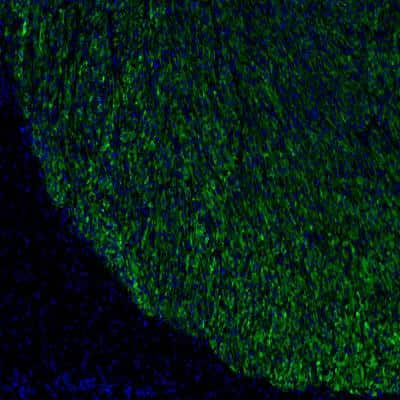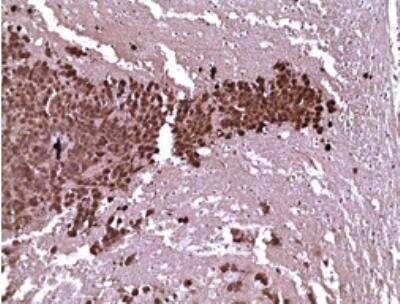Luciferase Antibody - BSA Free Best Seller
Novus Biologicals, part of Bio-Techne | Catalog # NB100-1677


Conjugate
Catalog #
Key Product Details
Species Reactivity
Validated:
Firefly
Cited:
Firefly
Applications
Validated:
ELISA, Immunocytochemistry/ Immunofluorescence, Immunohistochemistry, Immunohistochemistry-Frozen, Immunohistochemistry-Paraffin, Western Blot
Cited:
Block/Neutralize, IF/IHC, Immunocytochemistry/ Immunofluorescence, Immunohistochemistry, Immunohistochemistry-Frozen, Immunohistochemistry-Paraffin, Immunoprecipitation, Microarray, Western Blot
Label
Unconjugated
Antibody Source
Polyclonal Goat IgG
Format
BSA Free
Concentration
Please see the vial label for concentration. If unlisted please contact technical services.
Product Specifications
Immunogen
Luciferase [Photinus pyralis (Firefly)]
Reactivity Notes
No reactivity is observed against Sea pansy (Renilla reniformis) luciferase.
Specificity
No reactivity is observed against Sea pansy (Renilla reniformis) luciferase.
Clonality
Polyclonal
Host
Goat
Isotype
IgG
Description
This product is an IgG fraction antibody purified from monospecific antiserum by a multi-step process which includes delipidation, salt fractionation and ion exchange chromatography followed by extensive dialysis against the buffer stated above. Assay by immunoelectrophoresis resulted in a single precipitin arc against anti-Goat Serum as well as purified and partially purified Luciferase [Photinus pyralis (Firefly)]
Store vial at -20C prior to opening. Aliquot contents and freeze at -20C or below for extended storage. Avoid cycles of freezing and thawing. Centrifuge product if not completely clear after standing at room temperature. This product is stable for several weeks at 4C as an undiluted liquid. Dilute only prior to immediate use.
Store vial at -20C prior to opening. Aliquot contents and freeze at -20C or below for extended storage. Avoid cycles of freezing and thawing. Centrifuge product if not completely clear after standing at room temperature. This product is stable for several weeks at 4C as an undiluted liquid. Dilute only prior to immediate use.
Scientific Data Images for Luciferase Antibody - BSA Free
Immunohistochemical Analysis of Luciferase in Human Tumor Xenograft
Human tumor xenograft expressing firefly luciferase intracranially injected into a mouse brain. Image provided via product review by verified customer.Use of Luciferase Antibody in Western Blot
Lane 1: Luciferase, 50ng.Luciferase antibody at 1:1000 overnight at 4C. Secondary antibody: Peroxidase goat secondary antibody at 1:40,000 for 30 min at RT. Block: incubated with blocking buffer for 30 min at RT. Predicted/Observed size: 60 kDa for Luciferase. Other band(s): None.Immunocytochemistry/Immunofluorescence Staining of Luciferase in AIHV-1 Infected MDBK Cells
In vitro expression of Luciferase by 247Nluc+ recombinant strain of Alcelaphine herpesvirus 1 (AIHV-1). Epifluoresence expression of Luciferase by AIHV-1 infected syncytia. MDBK cells were infected with the WT (i to iv) or 247Nluc+ (v to viii) strain. Five days p.i. the the syncytia were fixed with 4% paraformaldehyde in PBS, permeabilized in 0.1% NP-40 in PBS and revealed by indirect IF co-staining. See image for additional details. Image provided via product review by verified customer.Applications for Luciferase Antibody - BSA Free
Application
Recommended Usage
ELISA
1:200-1:1000
Immunocytochemistry/ Immunofluorescence
20 ug/ml
Immunohistochemistry
1:1000-1:5000
Immunohistochemistry-Frozen
1:1000 - 1:5000
Immunohistochemistry-Paraffin
1:1000 - 1:5000
Western Blot
1:1000-1:5000
Application Notes
This antibody has been tested in Western Blot, IHC, and ELISA. Expect a band ~60kDa in appropriate cell lysates. Although not tested, this antibody would be useful in immunofluorescence, immunoprecipitation, immunocytochemistry, and most immunological methods requiring high titers and specificity.
Reviewed Applications
Read 7 reviews rated 4.9 using NB100-1677 in the following applications:
Formulation, Preparation, and Storage
Purification
Multi-step
Formulation
0.02 M Potassium Phosphate, 0.15 M Sodium Chloride, pH 7.2
Format
BSA Free
Preservative
0.01% Sodium Azide
Concentration
Please see the vial label for concentration. If unlisted please contact technical services.
Shipping
The product is shipped with polar packs. Upon receipt, store it immediately at the temperature recommended below.
Stability & Storage
Store at 4C short term. Store at -20C long term. Avoid freeze-thaw cycles.
Background: Luciferase
The luciferase assay is fast and sensitive, differentiating itself from the CAT (chloramphenicol acetyltransferase) assay because it does not require a radioactive substrate.
References
1. Eun, H. (1996). Marker/Reporter enzymes. Enzymology Primer for Recombinant DNA Technology, 567-645. doi:10.1016/b978-012243740-3/50011-9
2. McNabb, D. S., Reed, R., & Marciniak, R. A. (2005). Dual luciferase assay system for rapid assessment of gene expression in Saccharomyces cerevisiae. Eukaryotic Cell, 4(9), 1539-1549. doi:10.1128/ec.4.9.1539-1549.2005
3. Fraga, H. (2008). Firefly luminescence: A historical perspective and recent developments. Photochemical & Photobiological Sciences, 7(2), 146-158. doi:10.1039/b719181b
4. Younes, A., Lukyanenko, Y. O., Lyashkov, A. E., Lakatta, E. G., & Sollott, S. J. (2011). A bioluminescence method for direct measurement of phosphodiesterase activity. Analytical Biochemistry, 417(1), 36-40. doi:10.1016/j.ab.2011.05.036
Alternate Names
LuC, luciferin 4 monooxygenase, Luciferin 4-monooxygenase
UniProt
Additional Luciferase Products
Product Documents for Luciferase Antibody - BSA Free
Product Specific Notices for Luciferase Antibody - BSA Free
This product is for research use only and is not approved for use in humans or in clinical diagnosis. Primary Antibodies are guaranteed for 1 year from date of receipt.
